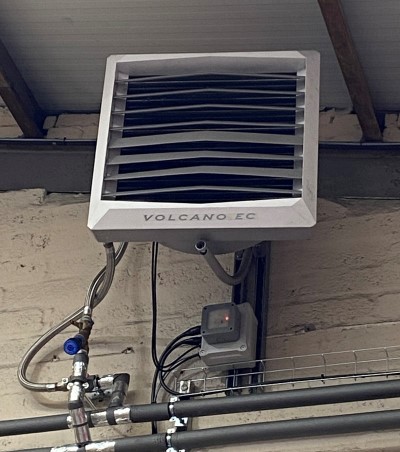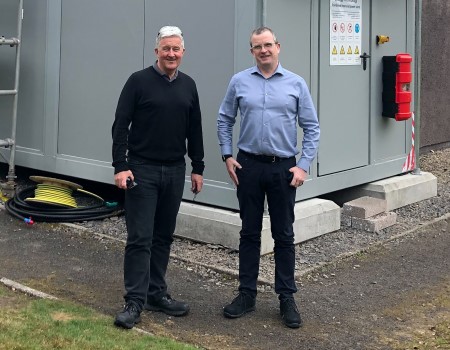The Kanthal site in Perth is home to the company’s Globar® Silicon Carbide (SiC) heating elements. Making heating elements from this precious and complex material is an energy-intensive process, and this places an even greater impetus on Kanthal to make its operations as clean and efficient as possible.
Steven McCluskie, Manufacturing Manager at Kanthal in Perth, explains:
“The production of heating elements has a positive impact on industrial processes globally, reducing emissions by shifting those processes from gas to electric,” he says. “Since our manufacturing processes here at Kanthal Perth require a great deal of energy, we are driven to address both the direct and indirect emissions from our own operations.”
The recent installation of a 520-kW electric Combined Heat and Power (CHP) system, along with a seven-year energy supply agreement for discounted electricity via its CHP installer, is set to reduce its electricity costs and usage significantly.
Heat and power generation in one system
“The CHP saves money because, as the name suggests, it combines heat and power generation in one system,” continues McCluskie, adding that the system is expected to reduce the plant’s energy costs by 12 percent annually based on current prices.
 Internal departamental fan heater in Production Unit, PerthThe CHP unit, which is fueled by natural gas, will help to reduce costs by displacing other, more costly forms of polluting energy generation solutions, like coal and conventional gas turbines - both of which are currently part of the UK’s energy mix. Furthermore, the waste heat from this system can also be used to heat other parts of the business.
Internal departamental fan heater in Production Unit, PerthThe CHP unit, which is fueled by natural gas, will help to reduce costs by displacing other, more costly forms of polluting energy generation solutions, like coal and conventional gas turbines - both of which are currently part of the UK’s energy mix. Furthermore, the waste heat from this system can also be used to heat other parts of the business.
“The CHP will enable us to use the heat it generates specifically to heat our manufacturing areas and site hot water. This minimizes our reliance on various older, less efficient and less sustainable gas boilers, gas radiant- and space heaters around our site,” continues McCluskie. “By bringing down our electricity costs and usage the CHP also supports Kanthal’s sustainability goals.”
Heating the plant
So far, required pipework has been installed, along with a water-pumping system linked to a heat exchanger on the CHP unit. The heat is pumped around the factory shop floor via a series of strategically placed high-level-mounted fan units. In addition, the pipework is linked to the office central-heating system and shower blocks to further offset the use of aging gas boilers.
 Steven McCluskie, Manufacturing Manager and Scott Lawson, Production Unit Manager, KanthalGoing forward, the CHP is projected to generate around one-third of the total power, and more than 80% of the Perth facility’s total heating and hot water requirements, equivalent to greater than 3GWh per year.
Steven McCluskie, Manufacturing Manager and Scott Lawson, Production Unit Manager, KanthalGoing forward, the CHP is projected to generate around one-third of the total power, and more than 80% of the Perth facility’s total heating and hot water requirements, equivalent to greater than 3GWh per year.
“Kanthal’s vision is to be number one in sustainable industrial heating technology,” Scott Lawson, PU Manager in Perth comments. “As a market leader with a truly global reach, our customers look to us to support their energy transformation, but we also have a duty to ensure that our own processes are as sustainable as possible.
“We will not stop here. We have ambitions to further expand on-site generation of electricity, in whatever form that may take,” he adds. “Technology is constantly developing and improving, providing new opportunities that were not previously viable. We plan to take advantage of this whenever possible.”
Facts
The new Combined Heat and Power (CHP) system in Perth will:
- Provide more than 80% of the facility’s heating and hot water requirements
- Generate around one-third of the total power for the facility
- Reduce the plant’s energy costs by 12 percent annually based on current prices
- Provide annual carbon savings to the UK national grid through to 2032
- Reduce Scope 1 emissions by 375 Te CO2e/year over seven years compared with the 2016-2018 baseline
- Deliver payback on investment in two years
In conjunction with the CHP, Perth has 19 active projects in the area of environmental and sustainability improvements, with target reductions of around 400 Te CO2e related to both Scope 1 and 2 emissions in 2022